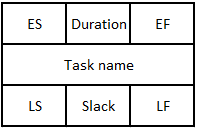Time management by CPM and 4D-planning
(→Method) |
|||
| Line 9: | Line 9: | ||
===Method=== | ===Method=== | ||
| + | [[File:CPM_1.png]] | ||
| + | |||
===Example=== | ===Example=== | ||
Revision as of 16:20, 9 June 2017
When having a project it is known that there is a start and an end date. Between those two dates different deadlines should be achieved for getting a satisfied result when the end date is reached. Therefore it will mean that the project depends a lot of the parameter time and when that parameter is represented it is known that the natural follower is cost. Therefore to reach the deadlines, a satisfied and economical satisfied result, it is t necessary to have a written well-organized plan. Especially the part to write a plan down is necessary, since research had showed that when goals are written down the rate of reach them is increased. Then what to do for time management and which tools can be used?
To planning in a good manner, there have been used many techniques and many different schedule schemes have been developed. One very useful and old method for time management, especially when the case has a lot of dependencies, is the critical path method (CPM). The CPM had been used in many construction cases but since the world changes in innovation, it is now possible to upgrade the CPM and make use of the 3D construction model which gives 4D-Planning. The methods CPM and 4D-Planning will be explained and by pros and cons the method will be evaluated.
Contents |
Critical path method (CPM)
History
After the Second World War the situation over the world was still strained. The tense was especially between the world’s two superpowers namely the United States of America and the Soviet Union. This tense between these super power countries is in the history defined as the Cold War. During that period both countries had a high priority on development and armament. One of the development phases in the 1950s was the US navy’s Polaris missile program. That program was not going as planned and the time schedule was delayed. Therefore the solution proposal for the program was to dividing the project into tasks and then connecting the tasks in relation to the dependence. The estimation of duration for each task was written and by that a schedule could give the duration time and the critical of the task(s) and for the whole program. At the same time an American chemical company called El DuPont de Nemours Company had delay problems. The chemical company and the US navy did cooperate in the 1950s to develop a system to manage the delay. The US navy called their solution for program evaluation review technique (PERT) while the chemical company did called it critical path method (CPM). The development of the method had shown its importance, since the management world did get a tool that could manage projects that have many dependencies in a smart way and showing the critical path of the projects. Today the method is implemented in software like Microsoft Project.
